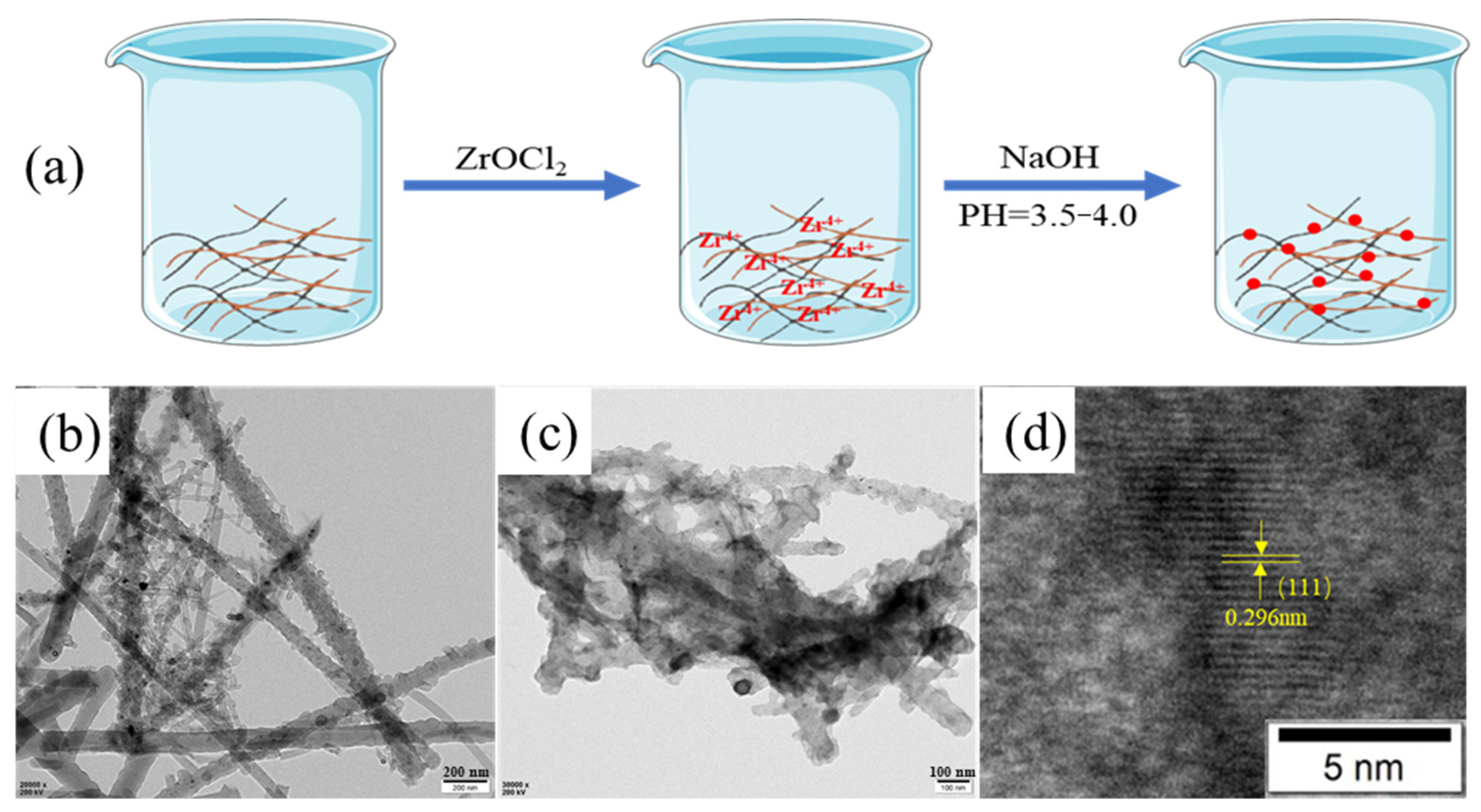Biomimetic Organic-Inorganic Hybrid Membranes for Removal of Fluoride Ions
Abstract
:1. Introduction
2. Materials and Methods
2.1. Materials and Reagents
2.2. The Functionalization of CNFs
2.3. Tailoring the Formation of Self-Assembled PNFs
2.4. Preparation of CaNF/PNF Nanohybrids and Biomimetic Synthesis of ZrO2 NPs
2.5. Adsorption Experiments of F− Ions
2.5.1. Effect of the Concentration of PNFs on F− Removal by the Membranes
2.5.2. Effect of Different Amounts of ZrO2 Precursor on F− Removal by the Membranes
2.5.3. Adsorption Effect of Membrane on F−-Containing Water Samples with Different Concentrations and Adsorption Capacity of the Membranes
2.6. Sustainability Analysis
2.7. Characterization Techniques
3. Results and Discussion
3.1. Morphology Characterization of CaNF
3.2. Morphology Characterization of PNFs
3.3. Characterization of CaNF/PNF Hybrid Materials
3.4. Characterization of Organic-Inorganic Hybrid Membranes
3.5. F− Ion Adsorption of Organic-Inorganic Hybrid Membranes
3.6. Sustainability Analysis
4. Conclusions
Author Contributions
Funding
Institutional Review Board Statement
Informed Consent Statement
Data Availability Statement
Acknowledgments
Conflicts of Interest
References
- Ben Said, A.; Telmoudi, C.; Louati, K.; Telmoudi, F.; Amira, D.; Hsairi, M.; Hedhili, A. Evaluation of the reliability of human teeth matrix used as a biomarker for fluoride environmental pollution. Ann. Pharm. Françaises 2020, 78, 21–33. [Google Scholar] [CrossRef] [PubMed]
- Chufa, B.M.; Murthy, H.C.A.; Gonfa, B.A.; Anshebo, T.Y. Carbon nanotubes: A review on green synthesis, growth mechanism and application as a membrane filter for fluoride remediation. Green Chem. Lett. Rev. 2021, 14, 640–657. [Google Scholar] [CrossRef]
- Jagtap, S.; Yenkie, M.K.; Labhsetwar, N.; Rayalus, S. Fluoride in Drinking Water and Defluoridation of Water. Chem. Rev. 2012, 112, 2454–2466. [Google Scholar] [CrossRef] [PubMed]
- Demelash, H.; Beyene, A.; Abebe, Z.; Melese, A. Fluoride concentration in ground water and prevalence of dental fluorosis in Ethiopian Rift Valley: Systematic review and meta-analysis. BMC Public Health 2019, 19, 1298. [Google Scholar] [CrossRef] [PubMed] [Green Version]
- Zhang, Q.R.; Bolisetty, S.; Cao, Y.P.; Handschin, S.; Adamcik, J.; Peng, Q.M.; Mezzenga, R. Selective and Efficient Removal of Fluoride from Water: In Situ Engineered Amyloid Fibril/ZrO2 Hybrid Membranes. Angew. Chem. Int. Ed. 2019, 58, 6012–6016. [Google Scholar] [CrossRef] [PubMed]
- Meenakshi, S.; Viswanathan, N. Identification of selective ion-exchange resin for fluoride sorption. J. Colloid Interface Sci. 2007, 308, 438–450. [Google Scholar] [CrossRef]
- Putkonen, M.; Szeghalmi, A.; Pippel, E.; Knez, M. Atomic layer deposition of metal fluorides through oxide chemistry. J. Mater. Chem. 2011, 21, 14461–14465. [Google Scholar] [CrossRef]
- Sanchez-Prado, L.; Llompart, M.; Lores, M.; Garcia-Jares, C.; Bayona, J.M.; Cela, R. Monitoring the photochemical degradation of triclosan in wastewater by UV light and sunlight using solid-phase microextraction. Chemosphere 2006, 65, 1338–1347. [Google Scholar] [CrossRef]
- Owusu-Agyeman, I.; Jeihanipour, A.; Luxbacher, T.; Schafer, A.I. Implications of humic acid, inorganic carbon and speciation on fluoride retention mechanisms in nanofiltration and reverse osmosis. J. Membr. Sci. 2017, 528, 82–94. [Google Scholar] [CrossRef]
- Amor, Z.; Bariou, B.; Mameri, N.; Taky, M.; Nicolas, S.; Elmidaoui, A. Fluoride removal from brackish water by electrodialysis. Desalination 2001, 133, 215–223. [Google Scholar] [CrossRef]
- Yao, G.L.; Zhu, X.T.; Wang, M.Y.; Qiu, Z.W.; Zhang, T.; Qiu, F.X. Controlled Fabrication of the Biomass Cellulose-CeO2 Nanocomposite Membrane as Efficient and Recyclable Adsorbents for Fluoride Removal. Ind. Eng. Chem. Res. 2021, 60, 5914–5923. [Google Scholar] [CrossRef]
- Pendergast, M.M.; Hoek, E.M.V. A review of water treatment membrane nanotechnologies. Energy Environ. Sci. 2011, 4, 1946–1971. [Google Scholar] [CrossRef] [Green Version]
- Zhang, J.; Chen, N.; Su, P.Y.; Li, M.; Feng, C.P. Fluoride removal from aqueous solution by Zirconium-Chitosan/Graphene Oxide Membrane. React. Funct. Polym. 2017, 114, 127–135. [Google Scholar] [CrossRef]
- Tu, Q.; Yang, Q.; Wang, H.; Li, S. Rotating carbon nanotube membrane filter for water desalination. Sci. Rep. 2016, 6, 26183. [Google Scholar] [CrossRef] [PubMed] [Green Version]
- Chen, P.; Liang, H.W.; Lv, X.H.; Zhu, H.Z.; Yao, H.B.; Yu, S.H. Carbonaceous Nanofiber Membrane Functionalized by beta-Cyclodextrins for Molecular Filtration. ACS Nano 2011, 5, 5928–5935. [Google Scholar] [CrossRef] [PubMed]
- Wang, Z.Q.; Wu, S.S.; Wang, J.; Yu, A.L.; Wei, G. Carbon Nanofiber-Based Functional Nanomaterials for Sensor Applications. Nanomaterials 2019, 9, 1045. [Google Scholar] [CrossRef] [PubMed] [Green Version]
- Zhou, X.X.; Wang, Y.; Gong, C.C.; Liu, B.; Wei, G. Production, structural design, functional control, and broad applications of carbon nanofiber-based nanomaterials: A comprehensive review. Chem. Eng. J. 2020, 402, 126189. [Google Scholar] [CrossRef]
- Azwar, E.; Wan Mahari, W.A.; Chuah, J.H.; Vo, D.V.N.; Ma, N.L.; Lam, W.H.; Lam, S.S. Transformation of biomass into carbon nanofiber for supercapacitor application—A review. Int. J. Hydrogen Energy 2018, 43, 20811–20821. [Google Scholar] [CrossRef]
- Chaos-Moran, R.; Campo, M.; Prolongo, S.G.; Escalera, M.D.; Urena, A. The functionalization of carbon nanofibers with 4,4′-diaminodiphenylmethane, a curing agent for epoxy resins. J. Mater. Res. 2009, 24, 1435–1445. [Google Scholar] [CrossRef]
- Dongil, A.B.; Bachiller-Baeza, B.; Guerrero-Ruiz, A.; Rodriguez-Ramos, I.; Martinez-Alonso, A.; Tascon, J.M.D. Surface chemical modifications induced on high surface area graphite and carbon nanofibers using different oxidation and functionalization treatments. J. Colloid Interface Sci. 2011, 355, 179–189. [Google Scholar] [CrossRef]
- Rasheed, A.; Howe, J.Y.; Dadmun, M.D.; Britt, P.F. The efficiency of the oxidation of carbon nanofibers with various oxidizing agents. Carbon 2007, 45, 1072–1080. [Google Scholar] [CrossRef]
- Mahar, F.K.; He, L.L.; Wei, K.; Mehdi, M.; Zhu, M.L.; Gu, J.; Zhang, K.Q.; Khatri, Z.; Kim, I. Rapid adsorption of lead ions using porous carbon nanofibers. Chemosphere 2019, 225, 360–367. [Google Scholar] [CrossRef] [PubMed]
- Zhou, X.X.; Liu, B.; Chen, Y.; Guo, L.; Wei, G. Carbon nanofiber-based three-dimensional nanomaterials for energy and environmental applications. Mater. Adv. 2020, 1, 2543. [Google Scholar] [CrossRef]
- Wang, M.X.; Guo, Z.Y.; Huang, Z.H.; Kang, F.Y. Preparation of porous carbon nanofibers with controllable pore structures for low-concentration NO removal at room temperature. New Carbon Mater. 2016, 31, 277–286. [Google Scholar] [CrossRef]
- Hu, J.D.; Chen, D.Y.; Li, N.J.; Xu, Q.F.; Li, H.; He, J.H.; Lu, J.M. In situ fabrication of Bi2O2CO3/MoS2 on carbon nanofibers for efficient photocatalytic removal of NO under visible-light irradiation. Appl. Catal. B-Environ. 2017, 217, 224–231. [Google Scholar] [CrossRef]
- Beck, R.J.; Zhao, Y.; Fong, H.; Menkhaus, T.J. Electrospun lignin carbon nanofiber membranes with large pores for highly efficient adsorptive water treatment applications. J. Water Process. Eng. 2017, 16, 240–248. [Google Scholar] [CrossRef]
- Kumar, P.S.; Venkatesh, K.; Gui, E.L.; Jayaraman, S.; Singh, G.; Arthanareeswaran, G. Electrospun carbon nanofibers/TiO2-PAN hybrid membranes for effective removal of metal ions and cationic dye. Environ. Nanotechnol. Monit. Manag. 2018, 10, 366–376. [Google Scholar] [CrossRef]
- Kong, H.; Chen, Y.; Yang, G.Z.; Liu, B.; Guo, L.; Wang, Y.; Zhou, X.; Wei, G. Two-dimensional material-based functional aerogels for treating hazards in the environment: Synthesis, functional tailoring, applications, and sustainability analysis. Nanoscale Horiz. 2022, 7, 112–140. [Google Scholar] [CrossRef]
- Wang, S.G.; Ma, Y.; Shi, Y.J.; Gong, W.X. Defluoridation performance and mechanism of nano-scale aluminum oxide hydroxide in aqueous solution. J. Chem. Technol. Biotechnol. 2009, 84, 1043–1050. [Google Scholar] [CrossRef]
- Mohan, S.; Singh, D.K.; Kumar, V.; Hasan, S.H. Effective removal of Fluoride ions by rGO/ZrO2 nanocomposite from aqueous solution: Fixed bed column adsorption modelling and its adsorption mechanism. J. Fluor. Chem. 2017, 194, 40–50. [Google Scholar] [CrossRef]
- Zhang, W.S.; Yu, X.Q.; Li, Y.; Su, Z.Q.; Jandt, K.D.; Wei, G. Protein-mimetic peptide nanofibers: Motif design, self-assembly synthesis, and sequence-specific biomedical applications. Prog. Polym. Sci. 2018, 80, 94–124. [Google Scholar] [CrossRef]
- Li, K.; Zhang, Z.; Li, D.; Zhang, W.; Yu, X.; Liu, W.; Gong, C.; Wei, G.; Su, Z. Biomimetic ultralight, highly porous, shape-adjustable, and biocompatible 3D graphene minerals via incorporation of self-assembled peptide nanosheets. Adv. Funct. Mater. 2018, 28, 2801056. [Google Scholar] [CrossRef]
- Peydayesh, M.; Mezzenga, R. Protein nanofibrils for next generation sustainable water purification. Nat. Commun. 2021, 12, 3248. [Google Scholar] [CrossRef]
- Chen, Y.; Yang, G.Z.; Liu, B.; Kong, H.; Xiong, Z.; Guo, L.; Wei, G. Biomineralization of ZrO2 nanoparticles on graphene oxide-supported peptide/cellulose binary nanofibrous membranes for high-performance removal of fluoride ions. Chem. Eng. J. 2022, 430, 132721. [Google Scholar] [CrossRef]
- Li, Z.H.; Cui, C.L.; Zhang, Z.Z.; Meng, X.X.; Yan, Q.L.; Ouyang, J.H.; Xu, W.L.; Niu, Y.Z.; Zhang, S.H. The Investigation of a Multi-Functional Peptide as Gelator, Dyes Separation Agent and Metal Ions Adsorbent. Chemistryselect 2019, 4, 7838–7843. [Google Scholar] [CrossRef]
- Ryu, J.; Kim, S.W.; Kang, K.; Park, C.B. Mineralization of Self-assembled Peptide Nanofibers for Rechargeable Lithium Ion Batteries. Adv. Mater. 2010, 22, 5537–5541. [Google Scholar] [CrossRef]
- Yu, X.Q.; Wang, Z.P.; Su, Z.Q.; Wei, G. Design, fabrication, and biomedical applications of bioinspired peptide-inorganic nanomaterial hybrids. J. Mater. Chem. B 2017, 5, 1130–1142. [Google Scholar] [CrossRef]
- Paul, S.; Basu, K.; Das, K.S.; Banerjee, A. Peptide-Based Hydrogels as a Scaffold for In Situ Synthesis of Metal Nanoparticles: Catalytic Activity of the Nanohybrid System. Chemnanomat 2018, 4, 882–887. [Google Scholar] [CrossRef]
- Yang, D.; Li, Y.B.; Wang, Y.G.; Jiang, Z.Y. Bioinspired synthesis of mesoporous ZrO2 nanomaterials with elevated defluoridation performance in agarose gels. RSC Adv. 2014, 4, 49811–49818. [Google Scholar] [CrossRef]
- Qin, H.; Guo, W.M.; Liu, J.X.; Xiao, H.N. Size-controlled synthesis of spherical ZrO2 nanoparticles by reverse micelles-mediated sol-gel process. J. Eur. Ceram. Soc. 2019, 39, 3821–3829. [Google Scholar] [CrossRef]
- Guo, M.Y.; Wang, G.X.; Zhao, Y.C.; Li, H.T.; Tang, K.; Zhao, Y.B.; Burgess, K. Preparation of Nano-ZrO2 powder via a microwave-assisted hydrothermal method. Ceram. Int. 2021, 47, 12425–12432. [Google Scholar] [CrossRef]
- Burck, J.; Aras, O.; Bertinetti, L.; Ilhan, C.A.; Ermeydan, M.A.; Schneider, R.; Ulrich, A.S.; Kazanci, M. Observation of triple helix motif on electrospun collagen nanofibers and its effect on the physical and structural properties. J. Mol. Struct. 2018, 1151, 73–80. [Google Scholar] [CrossRef]
- Wei, G.; Zhang, J.M.; Usuelli, M.; Zhang, X.F.; Liu, B.; Mezzenga, R. Biomass vs inorganic and plastic-based aerogels: Structural design, functional tailoring, resource-efficient applications and sustainability analysis. Prog. Mater. Sci. 2022, 125, 100915. [Google Scholar] [CrossRef]
- Grzegorzek, M.; Majewska-Nowak, K.; Ahmed, A.E. Removal of fluoride from multicomponent water solutions with the use of monovalent selective ion-exchange membranes. Sci. Total Environ. 2020, 722, 137681. [Google Scholar] [CrossRef]
- Huang, H.M.; Liu, J.H.; Zhang, P.; Zhang, D.D.; Gao, F.M. Investigation on the simultaneous removal of fluoride, ammonia nitrogen and phosphate from semiconductor wastewater using chemical precipitation. Chem. Eng. J. 2017, 307, 696–706. [Google Scholar] [CrossRef]







Publisher’s Note: MDPI stays neutral with regard to jurisdictional claims in published maps and institutional affiliations. |
© 2022 by the authors. Licensee MDPI, Basel, Switzerland. This article is an open access article distributed under the terms and conditions of the Creative Commons Attribution (CC BY) license (https://creativecommons.org/licenses/by/4.0/).
Share and Cite
Chen, Y.; Kong, H.; Guo, L.; Wei, G. Biomimetic Organic-Inorganic Hybrid Membranes for Removal of Fluoride Ions. Materials 2022, 15, 3457. https://doi.org/10.3390/ma15103457
Chen Y, Kong H, Guo L, Wei G. Biomimetic Organic-Inorganic Hybrid Membranes for Removal of Fluoride Ions. Materials. 2022; 15(10):3457. https://doi.org/10.3390/ma15103457
Chicago/Turabian StyleChen, Yun, Hao Kong, Lei Guo, and Gang Wei. 2022. "Biomimetic Organic-Inorganic Hybrid Membranes for Removal of Fluoride Ions" Materials 15, no. 10: 3457. https://doi.org/10.3390/ma15103457






